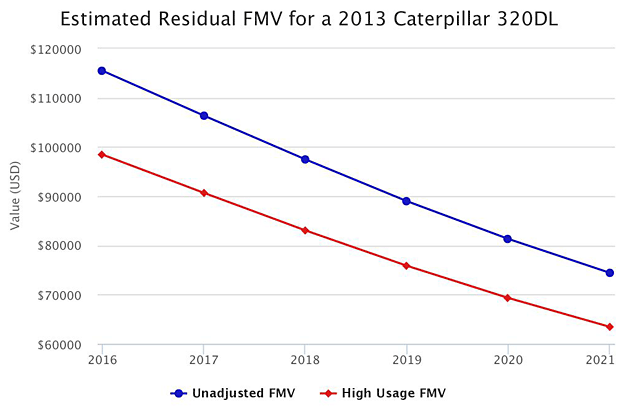In the constant grind to produce accurate current and forecasted values for equipment, many finance professionals often overlook usage, which leverages a substantial amount of power where values are concerned. A discerning consumer would never buy a used car without checking the odometer. Yet too often we see off-highway equipment valuations fail to truly account for the impact of usage, which can lead to reduced accuracy in current portfolio values and estimated residual values.
To fully understand the impact of usage during equipment valuation, one must first identify a metric to measure usage and benchmark that usage metric against the rest of the market. With the continued improvement of telematics data, it is now much easier for equipment owners to provide detailed information about the “wear and tear” on all major components of most equipment types. However, if this data is lacking for equipment in a fleet or portfolio, many industry leaders in the equipment valuation space will rely on engine hours as the defining measure of usage.
Once a consistent usage measurement is established, the next step is to properly benchmark that particular piece of equipment against other similar assets. It’s paramount to recognize that none of the factors required to properly value used equipment exist in a vacuum. Equipment condition oscillates with region thanks to climatic patterns, and usage trends tend to exhibit high multicollinearity with equipment age. This interplay can be easily controlled by combining age and usage into a single factor, which is often referred to as annualized usage. This measurement of the average number of use hours acquired each year is a much better predictor of used equipment value than either age or usage.
If a reliable source of usage metrics are not available for benchmarking, it may be possible to connect the dots on the impact of annualized meter reads given other valuable descriptive information. Regional influence can be isolated using weather data — areas with long, hot summers tend to accrue more hours of use than areas with long, harsh winters by extending the number of days equipment can be safely used on projects. Industry considerations are also very important where usage is concerned. Some sectors, such as mining, tend to run double or triple shifts on large equipment, turning the machine off only long enough to switch out operators. These types of equipment can run up to 21 hours a day for the lifetime of any particular project. In some instances, a three-year-old machine coming out of mining companies with such high hours could exhibit the same FMV and FLV as a ten-year-old machine emerging from a less-intensive area.
The long-term effects of usage on valuation can be staggering, especially once these effects are compounded over several years. For example, consider a revision to the scenario above. Let’s say that a Caterpillar 320DL, a very popular crawler mounted hydraulic excavator, needs to be assigned both a fair market value and given a five-year residual value. The average excavator of that size accrues about 800 engine hours each year, so if one ignores the impact of meter reads and uses the market average, one may reasonably assign an FMV of $115,474 and estimated residual value at the end of five years to be about $74,425 (in current U.S. dollars).
However, imagine that the same excavator has come out of an industry in which overuse and double-shifts are common, leading it to accrue twice as many engine hours per year. The addition of 1,600 hours per year, with the expectation of continued high usage, drops the estimated residual value at the end of five years to $63,446—a drop of 17.3% in value. This difference in value, compounded across an equipment portfolio, can be devastating to project bottom lines.

Analysis of the importance of any metric in creating a fair market value must of course come with caveats — not all usage hours are created equally. For example, if using engine hours to measure usage, one should be wary of equipment types in which engines are not active while the machine is in use. For example, consider aerial work platforms — in some instances, the engine may run only long enough to raise or lower the platform. In this case, engine hours are a poor indicator of how usage should impact valuation. Alternatively, consider the high cost of seasonality in valuing agricultural equipment.
Combines have no practical use for ten months of each year, a fact which must be considered when valuing these and other specialty-use types of equipment.
Valuing used equipment efficiently and accurately can be a daunting task for financial professionals, especially taking into consideration the many important factors that weigh into the calculation. With heavy equipment, usage is one of the most important elements of an accurate valuation and should never be ignored, unless managers are willing to accept high and unpredictable variance in fleet and portfolio value.